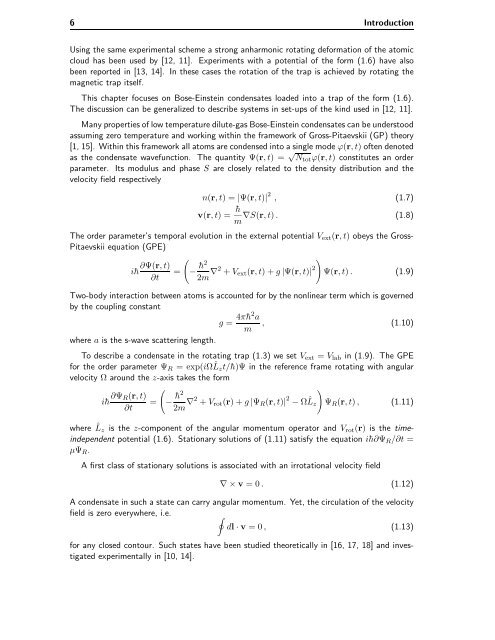Bose-Einstein Condensates in Rotating Traps and Optical ... - BEC
Bose-Einstein Condensates in Rotating Traps and Optical ... - BEC
Bose-Einstein Condensates in Rotating Traps and Optical ... - BEC
Create successful ePaper yourself
Turn your PDF publications into a flip-book with our unique Google optimized e-Paper software.
6 Introduction<br />
Us<strong>in</strong>g the same experimental scheme a strong anharmonic rotat<strong>in</strong>g deformation of the atomic<br />
cloud has been used by [12, 11]. Experiments with a potential of the form (1.6) have also<br />
been reported <strong>in</strong> [13, 14]. In these cases the rotation of the trap is achieved by rotat<strong>in</strong>g the<br />
magnetic trap itself.<br />
This chapter focuses on <strong>Bose</strong>-<strong>E<strong>in</strong>ste<strong>in</strong></strong> condensates loaded <strong>in</strong>to a trap of the form (1.6).<br />
The discussion can be generalized to describe systems <strong>in</strong> set-ups of the k<strong>in</strong>d used <strong>in</strong> [12, 11].<br />
Many properties of low temperature dilute-gas <strong>Bose</strong>-<strong>E<strong>in</strong>ste<strong>in</strong></strong> condensates can be understood<br />
assum<strong>in</strong>g zero temperature <strong>and</strong> work<strong>in</strong>g with<strong>in</strong> the framework of Gross-Pitaevskii (GP) theory<br />
[1, 15]. With<strong>in</strong> this framework all atoms are condensed <strong>in</strong>to a s<strong>in</strong>gle mode ϕ(r,t) often denoted<br />
as the condensate wavefunction. The quantity Ψ(r,t)= √ Ntotϕ(r,t) constitutes an order<br />
parameter. Its modulus <strong>and</strong> phase S are closely related to the density distribution <strong>and</strong> the<br />
velocity field respectively<br />
n(r,t)=|Ψ(r,t)| 2 , (1.7)<br />
v(r,t)= ¯h<br />
∇S(r,t) . (1.8)<br />
m<br />
The order parameter’s temporal evolution <strong>in</strong> the external potential Vext(r,t) obeys the Gross-<br />
Pitaevskii equation (GPE)<br />
i¯h ∂Ψ(r,t)<br />
<br />
= −<br />
∂t<br />
¯h2<br />
2m ∇2 + Vext(r,t)+g |Ψ(r,t)| 2<br />
<br />
Ψ(r,t) . (1.9)<br />
Two-body <strong>in</strong>teraction between atoms is accounted for by the nonl<strong>in</strong>ear term which is governed<br />
by the coupl<strong>in</strong>g constant<br />
g = 4π¯h2 a<br />
, (1.10)<br />
m<br />
where a is the s-wave scatter<strong>in</strong>g length.<br />
To describe a condensate <strong>in</strong> the rotat<strong>in</strong>g trap (1.3) we set Vext = Vlab <strong>in</strong> (1.9). The GPE<br />
for the order parameter ΨR = exp(iΩˆ Lzt/¯h)Ψ <strong>in</strong> the reference frame rotat<strong>in</strong>g with angular<br />
velocity Ω around the z-axis takes the form<br />
i¯h ∂ΨR(r,t)<br />
∂t<br />
=<br />
<br />
− ¯h2<br />
2m ∇2 + Vrot(r)+g |ΨR(r,t)| 2 − Ω ˆ Lz<br />
<br />
ΨR(r,t) , (1.11)<br />
where ˆ Lz is the z-component of the angular momentum operator <strong>and</strong> Vrot(r) is the time<strong>in</strong>dependent<br />
potential (1.6). Stationary solutions of (1.11) satisfy the equation i¯h∂ΨR/∂t =<br />
µΨR.<br />
A first class of stationary solutions is associated with an irrotational velocity field<br />
∇×v =0. (1.12)<br />
A condensate <strong>in</strong> such a state can carry angular momentum. Yet, the circulation of the velocity<br />
field is zero everywhere, i.e. <br />
dl · v =0, (1.13)<br />
for any closed contour. Such states have been studied theoretically <strong>in</strong> [16, 17, 18] <strong>and</strong> <strong>in</strong>vestigated<br />
experimentally <strong>in</strong> [10, 14].




